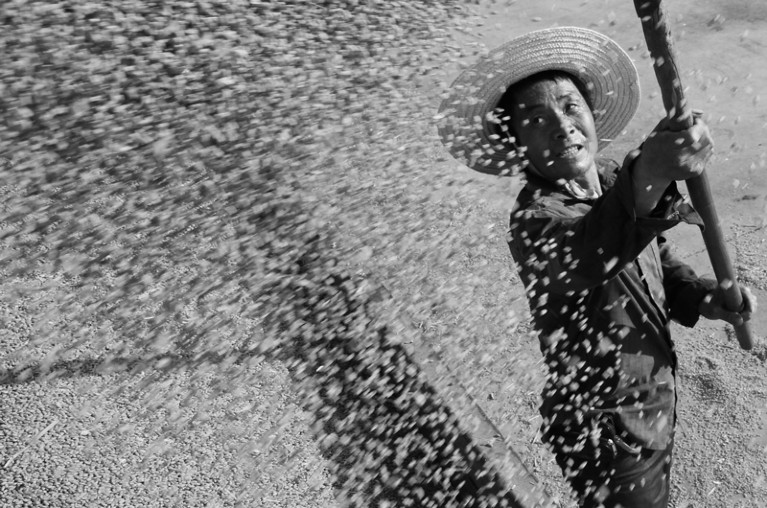
A giant experiment with 21 million farmers in China points the way to sustainable agriculture.Credit: Feng Xiaomin/Xinhua/eyevine
In 1958, China under Mao Zedong embarked on a nationwide political project to increase agricultural productivity by collectivizing small farms across the country and forcing them to share agricultural tools. It was a disaster and contributed to a famine in which tens of millions died.
Now science has succeeded where ideology failed. A huge, decade-long experiment involving millions of farmers reports its results this week. Writing in Nature, scientists in China describe how they identified and passed on evidence-based techniques to make smallholder farming in the country more efficient (Z. Cui et al. Nature http://dx.doi.org/10.1038/nature25785; 2018). No sharing of agricultural tools was required; just the gathering and pooling of scientific data on local conditions and agricultural needs.
Running from 2005 to 2015, the project first assessed how factors including irrigation, plant density and sowing depth affected agricultural productivity. It used the information to guide and spread best practice across several regions: for example, recommending that rice in southern China be sown in 20 holes densely packed in a square metre, rather than the much lower densities farmers were accustomed to using.
The results speak for themselves: maize (corn), rice and wheat output grew by some 11% over that decade, whereas the use of damaging and expensive fertilizers decreased by between 15% and 18%, depending on the crop. Farmers spent less money on their land and earned more from it — and they continue to do so.
The results offer hope in the search for a more sustainable future on a crowded planet. After all, some 2.5 billion smallholders together farm 60% of the world’s arable land. Beyond that, the project provides many lessons. First, that a scientific approach can increase agricultural productivity and cut damage to the environment. Second, that such success requires investment in what economists call the intangibles — the creation of networks to spread information and give scientists access to essential data. The scale of the research network created is impressive: 1,200 scientists, 65,000 local officials, 140,000 industry representatives and 21 million farmers across 37.7 million hectares.
Maintaining the people in those networks — in this case, the technicians and bureaucrats in local government offices — is a must. The study shows how these posts can produce benefit, both economic and environmental, far beyond what they cost. Unfortunately, in many countries, such jobs and the networks that depend on them are being cut back, often, paradoxically, in the name of efficiency.
The third lesson is that the same methods could, in principle, be used to boost agricultural efficiency elsewhere. But that will not be easy. China has well-developed regional infrastructure and relatively efficient central control, both of which allowed this project to operate on such a large scale. India and Africa — two regions that could benefit from a similar approach — do not. That makes it difficult, although not impossible, to translate the study and the results beyond China.
Fourth, the programme must be monitored and updated. Its recommendations were fine-tuned to the needs of farmers in specific regions, but these can change, especially as the climate alters. To consolidate their success, the farmers and scientists involved should continue to adapt the recommended methods.
China must now build on this project. Some 200 million smallholdings are not yet plugged into the information networks set up and so are not applying the recommendations. There is scope for easy wins here. For example, researchers could piggyback on existing but separate networks. One is the Science and Technology Backyard platforms, which operate in 21 provinces and cover a wide range of crops. They bring agricultural scientists to live in villages, and use demonstrations to show farmers better techniques. Such projects could ensure that farmers continue to learn. They could also be expanded to investigate the best use of other agricultural options, such as pest management and the use of legumes as alternatives to fertilizers.
Perhaps the most important lesson is that better use of existing technology can help to produce more food in a sustainable way. None of the recommendations given to China’s farmers would have surprised agronomists. Still, the scientists involved deserve great credit for having the vision and the wherewithal to make the project happen.
There is a thrill in finding that expectations hold up over so grand a scale. And, ultimately, it was that scale that made the difference. It allowed the project to go where even the best smaller studies (and Mao Zedong) could not: persuading often intractable rural farmers to change their practices, and so improve efficiency and productivity.

 Millions of Chinese farmers reap benefits of huge crop experiment
Millions of Chinese farmers reap benefits of huge crop experiment
 A collaboration worth its weight in grain
A collaboration worth its weight in grain


